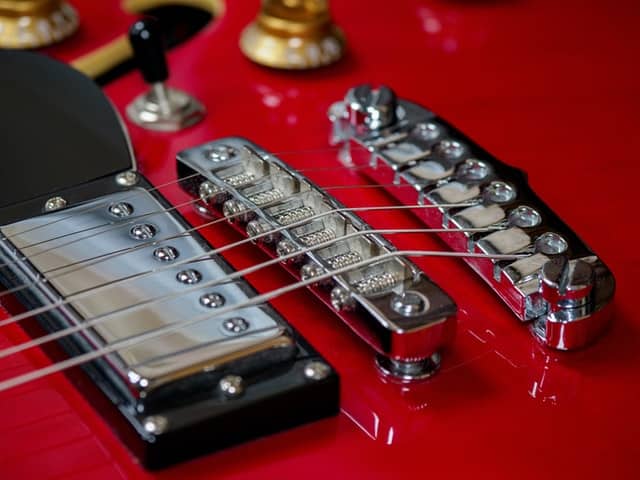Bridge saddle lubricants are a relatively new product in the guitar industry and it’s often argued whether they help or harm your guitar. Most players would agree that lubricants help to increase the lifespan of the parts they’re used on.
Lubricants are about trying to minimize contact friction so the point of application should be where the strings rest on the bridge saddles. You also want to make sure whatever you’re applying doesn’t spill or go anywhere unintended.
Many guitarists believe you should lubricate all parts that are a point of contact for the strings on your guitar. The problem with some lubricants is that they can have penetrating and damaging effects if not applied properly so today, I’m going to show you how to prevent unwanted damage while taking care of your guitar.
What kind of lubricant should you use on bridge saddles?
If you’re looking to lubricate your bridge saddle using trusted names, you could try one of the following:
- MusicNomad makes a lot of lubricant products for both the nut and bridge of guitars
- Big Bends nut sauce, comes with an applicator
- Planet Waves PWLBK01 Lubrikit Friction Remover
- D’Addario Lubrikit Friction Remover Guitar Nut Lubricator
It should be noted that most lubricants are based on petroleum jelly mixtures and these jellies will harden over time and may even cause sticking points on the bridge saddle. Some guitarists recommend using pencil graphite instead, but it can be messy.
Another alternative is to file and grind any choke points that may form on the metal due to repeated use.
If you do it this way, you should be careful to use a soft rubber that will basically polish the metal to a smoothness again, anything harder and you’ll just leave scratches and scarring.
Less common lubricants are:
- Wax, like waxed dental tape or candle wax
- Household oils and mineral oils, be sparing and careful if you use this because they’re penetrative, meaning they can ruin your guitar
- Graphite, like in pencil tips
I want to talk about penetrative properties before we move on to the how of applying a lubricant. You should be careful to not use lubricants that have strong penetrating properties. They can draw into parts of your guitar and shorten their lifespan.
As for household oils, don’t use any vegetable oils as they’ll turn rancid over time and make your guitar stink.
A lot of it comes down to preference though, and everyone has their opinions at the end of the day. If you find an alternative to any of these that works better for you, feel free to use that instead.
How do you apply lubricant to guitar bridge saddles?
Quite the same way you apply lubricant to anything, carefully and sparingly.
Before you lube up your bridge saddle, you will need to lay your guitar down on a horizontal surface. Then, use low-tack tape to isolate the bridge as much as you can, covering all the nearby parts of your guitar like the knobs and pickguard.
After you’ve prepped your guitar, you can begin to apply lubricant to the necessary parts. Your bridge saddle will probably have grooves where your strings sit and that’s where you want to apply the lubricant.
Your particular brand of lubricant may come with a nozzle for application, but if it doesn’t there are a few things you could use.
- You can use a thin nozzled syringe
- You can use a ballpoint pen tip
- You can use a straw tip, and cut it into a sharp needle-like point
You’ll want to apply a very small amount to each notch, just enough that the string will be able to snuggly sit on top of it without pushing too much excess lubricant off the bridge saddle.
Why should you lubricate your bridge saddles?
The bridge saddle is a contact point, in other words, a point of the guitar that the strings rest on and are constantly rubbing against. You may not see it while playing, but there’s a lot of small movement happening down on the saddles, whenever you bend or pluck a string.
Mainly you lubricate to avoid friction building up on your bridge saddle. Over time, the strings rubbing on the metal parts of the saddle will create small points of friction that can cause strings to snap more easily. Lubricating or filing them regularly prevents this.
How often should you lubricate your saddles?
For best practice, you should lubricate them a little each time you switch out your strings. If you use petroleum-based lubricants, you may notice that as they dry up, they’ll deaden the sound of your strings a little, this is pretty normal in most cases.
If you have a lubricant with a particularly penetrative aspect (which you generally shouldn’t) you should avoid lubricating any part of your guitar too often as it will damage your guitar’s components over time.
What happens if you have never lubricated your saddles?
Depending on how old your guitar is, it could be inconsequential. If you’ve had your guitar for more than a few years though, you may find that your strings last less long and they come out of tune more often.
In the most severe cases, where bridge saddles have been left unattended on a neglected guitar in a dusty attic, you’re likely to face rust. At that point, you would be wise not to string your guitar before cleaning it.
At the end of the day, a lot of your guitar’s condition is determined by where you store it, how well you treat it, and the humidity of the environment you live in. These factors will determine a lot of your maintenance needs.
Personally, I just like to keep the bridge as clean as possible by giving it a wipe with a microfibre cloth whenever I do a string change.
A little bit of graphite does the trick for me and I’m spared the worry of rust or oil getting into any unwanted places.

Hello there, my name is Ramiro and I’ve been playing guitar for almost 20 years. I’m obsessed with everything gear-related and I thought it might be worth sharing it. From guitars, pedals, amps, and synths to studio gear and production tips, I hope you find what I post here useful, and I’ll try my best to keep it entertaining also.





